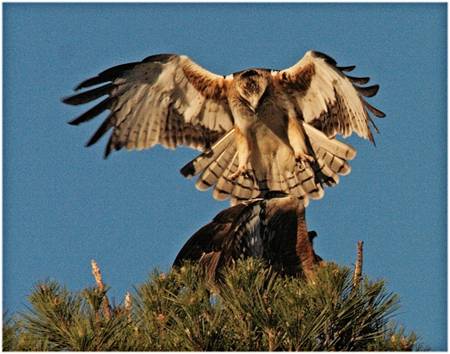I think this arises out of conversations I have been having with
Julian about the FSP birds and the matter of ID-ing LE plumage variations generally.
You will recall Julian’s message about a ‘different-plumaged’
second bird with the light-morph. Subsequently we exchanged messages
about what bird was what and later watched 2 birds at the site, discussing what
they were in terms of age, sex, morph etc. Julian sent me a pic of the
second bird, and I suggested the possibility it might be a juvenile from his
behaviour description, and given the underbody illustrations of the ‘juvenile,
light morph’ in Hanzab/Debus. [I might mention that in my copies
the same ID illustrations are printed as paler overall in the Debus guide than they
appear in the Hanzab originals.] This would have raised an interesting
question about where the juv came from. I suggested to Julian that we
needed an underwing shot of the second bird, and I take it that the second bird
below is ‘it’.
Now, let’s back-track to last year. Others might
have different views but I had thought that the ‘pair’ at FSP
consisted of a light morph (male)and a somewhat darker (female) bird. I
had assumed that a reported dark morph from around Mount Ainslie/Campbell Park
was from a different pair (or even in some reports a Whistling Kite). Due
to a computer misfortune I do not have pics of it from last Spring, but this
bird shot earlier this year is probably it. (There is an old video-frame
of mine of the dark morph female from E O’Malley in the photogallery.)

Now, as to differences between morphs, the ‘dark’
and ‘light’ dichotomy seems to be firmly established. However
Hanzab/Debus picture a ‘dark morph’ and ‘dark morph, darkest
birds’, and Hanzab states ‘plumage varies considerably within
morphs’, that females ‘tend to be darker and more heavily
streaked on underbody’, and that juveniles are ‘separable’ ie
different. Apart from general darkness, a main difference between
the two morphs is that underwing the diagnostic pale ‘M’ is said to
occur only in the light morph, hence my request to Julian for an
underwing shot. Julian’s below pics clearly show the M in the light
morph. The second pic is a little difficult to interpret as to lighting,
but tends to show no ‘M’ (the dark leading edge being more
extensive), suggesting a lightish ‘dark morph’. Perhaps it is
best described as an ‘intermediate morph’. The ‘darker
female’ theory lacks logic. Darker than what? A ‘darker’
female ‘light morph’ would presumably be lighter than a male ‘dark
morph’.
I note that in the closely related Booted Eagle a third morph, ‘rufous
morph’ is recognised.
I now think that the birds currently at FSP are a mated pair,
any difference from last year’s plumage in the female being due to condition
of the plumage. Yesterday when I was there with Julian the male
made what seemed to be a (rejected) pre-copulatory pass. Is there a ‘(PCP(R))’
‘ code for the database breeding records?(Julian’s simultaneous snap
is no doubt superior but here it is anyway).

As to Julian’s question about the appropriateness of this
kind of discussion, well, I’ve previously acknowledged everyone has their
own preferences, sometimes strong ones. It doesn’t matter much to
me as I’m happy to exchange views on the matter directly with Julian or
anyone else who is interested.
From: Julian Robinson
[
Sent: Saturday, 7 July 2007 9:39 AM
To: 'canberrabirds- chatline'
Subject: RE: [canberrabirds] An unusual bird?
Thanks Stephen and yes it is one of the much-observed
Fyshwick Sewerage Works Little Eagles. My motivation in posting was that I
don't see any of the "M" pattern in this bird :), no more than in a
half dozen other species. To me the wing pattern alone looks more like my
Pizzey images of a Spotted Harrier, and wing + tail looks more like a Swamp
Harrier. I realise there are other signs, and for example the body
chunkiness seems to be characteristic of LE, but my questions are about plumage
- what you might see from a distance.
![[]](jpgoew8b9s_9G.jpg) light morph
light morph
![[]](jpgEJtyC5brN9.jpg) subject bird
subject bird
The light-morph LE clearly has what I thought was the "M" pattern (in
white), but I don't see it at all in the subject bird. Plumage also
doesn't look like any illustration I've got of a dark morph, or immature LE,
hence the question. In short - what is it that immediately
identifies this as a LE to the experienced birder? and b) does anyone know
about the morph/age/whatever status of this particular bird as indicated by its
plumage? Do intermediate morphs actually exist?
If I am irritating people by posting this kind of question, can someone tell me
discreetly or otherwise the approved COG forum to discuss this. It seems to me
that the chatline is the perfect place for this kind of learning, although it
probably contradicts the original purpose when it was set up to replace the
telephone line.
Julian
At 06:33 PM 6/07/2007, Stephen Mugford wrote:
OK, let me be
first and crude. This is a Little Eagle. The short tail and underwing
‘M’ pattern say that to me. Looks just like one of the pair I saw
about 4 weeks ago near Kelly’s Swamp. As to age and gender, real birdos
can take over now.
Stephen

